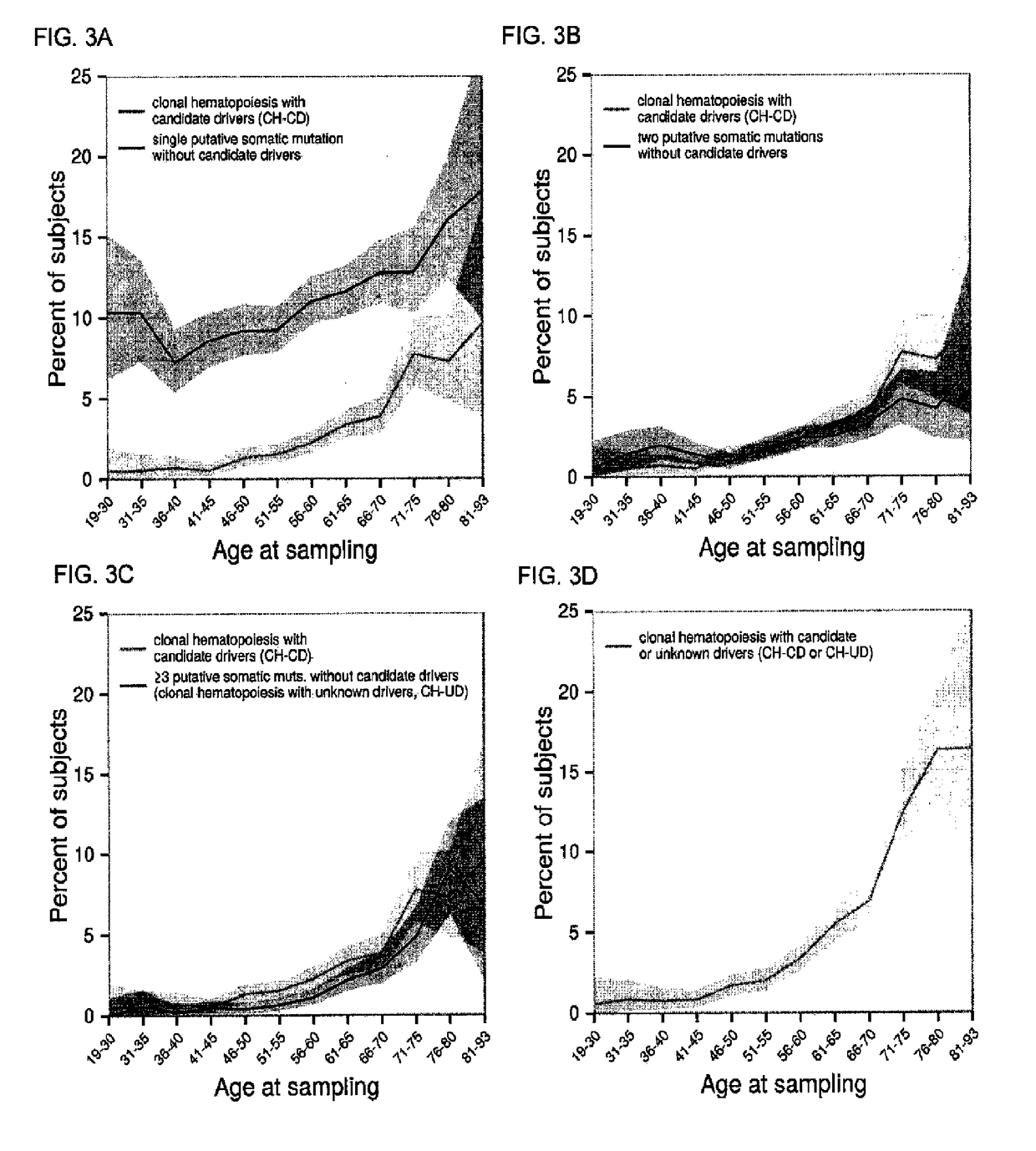Clonal haematopoiesis
a technology of clonal haematopoiesis and clonal expansion, which is applied in the field of clonal haematopoiesis, can solve problems such as prone to accumulation of mutations, and achieve the effect of reducing the incidence of haematopoietic clones comprising said mutation(s) in the subject's blood
- Summary
- Abstract
- Description
- Claims
- Application Information
AI Technical Summary
Benefits of technology
Problems solved by technology
Method used
Image
Examples
example 1
Identification of Characteristic Mutations and Candidate Drivers in Clonal Haematopoiesis
[0240]The exome sequences from 12,380 individuals were analysed and 3,111 putative somatic mutations identified based on their presence at unusual allelic fractions corresponding to an average of approximately one putative somatic mutation for every four subjects.
[0241]In detail, a total of 12,380 Swedish research participants with psychiatric diagnoses (Table S1) were ascertained from the Swedish National Hospital Discharge Register, which captures all inpatient hospitalizations. Controls were randomly selected from population registers. We treated cases and controls as a single cohort for all analyses presented below, as none of the mutational variables analyzed below showed any relationship to psychiatric diagnosis after controlling for other factors such as age and smoking.
[0242]Excluding bipolar subjects, medical histories (from 1965 to 2011) of 11,164 of the subjects enrolled in the study ...
example 2
DNMT3A and Other Driver Mutations
[0276]We further performed validation for 30 candidate driver somatic mutations from two well-known recurrently mutated sites. DNMT3A p.R882H and JAK2 p.V617F. These were genotyped using TaqMan fluorescent assays in a droplet-based digital PCR system.12 Relative concentrations of each allele were quantitated through multiplexed fluorophores counted across approximately 15,000 nanoliter-sized droplets. Each somatic mutation that we attempted to validate was confirmed as somatic, including five JAK2 p.V617F mutations mutations showing at allelic fractions close to or above 50% (FIG. 12), as would be expected as a consequence of a loss-of-heterozygosity event (Kralovics, R. et al. A gain-of-function mutation of JAK2 in myeloproliferative disorders. N. Engl. J. Med. 352, 1779-1790 (2005)).
[0277]A total of 190 mutations across 185 subjects were identified in the DA? IT3A gene (Table S4). Studies of mutations in haematologic malignancies have found DNMT3A ...
example 3
Clonal Haematopoiesis with Unknown Drivers
[0285]Somatic mutations may either be “drivers” that contribute to clonal expansion or simply passive “passengers”. We tested whether subjects with clonal haematopoiesis with candidate drivers (CH-CD) also tended to carry additional putative somatic mutations. Subjects with CH-CD did indeed tend to carry more putative somatic mutations overall (mean 1.5, in addition to the candidate driver mutations themselves) than subjects without candidate drivers did (mean 0.23, FIG. 2D); this observation remained significant after correcting for age (P<0.001).
[0286]Some 459 subjects had multiple putative somatic mutations without any of the candidate drivers described above. When multiple mutations were observed in the same individual, such mutations tended to have more-similar allelic fraction estimates than pairs of somatic mutations ascertained in different individuals (P<0.001, Mann-Whitney test for allelic fraction differences within and between su...
PUM
| Property | Measurement | Unit |
|---|---|---|
| Fraction | aaaaa | aaaaa |
| Fraction | aaaaa | aaaaa |
| Time | aaaaa | aaaaa |
Abstract
Description
Claims
Application Information
 Login to View More
Login to View More - R&D
- Intellectual Property
- Life Sciences
- Materials
- Tech Scout
- Unparalleled Data Quality
- Higher Quality Content
- 60% Fewer Hallucinations
Browse by: Latest US Patents, China's latest patents, Technical Efficacy Thesaurus, Application Domain, Technology Topic, Popular Technical Reports.
© 2025 PatSnap. All rights reserved.Legal|Privacy policy|Modern Slavery Act Transparency Statement|Sitemap|About US| Contact US: help@patsnap.com



